+Search query
-Structure paper
| Title | Structural basis for assembly and function of a diatom photosystem I-light-harvesting supercomplex. |
|---|---|
| Journal, issue, pages | Nat Commun, Vol. 11, Issue 1, Page 2481, Year 2020 |
| Publish date | May 18, 2020 |
 Authors Authors | Ryo Nagao / Koji Kato / Kentaro Ifuku / Takehiro Suzuki / Minoru Kumazawa / Ikuo Uchiyama / Yasuhiro Kashino / Naoshi Dohmae / Seiji Akimoto / Jian-Ren Shen / Naoyuki Miyazaki / Fusamichi Akita /  |
| PubMed Abstract | Photosynthetic light-harvesting complexes (LHCs) play a pivotal role in collecting solar energy for photochemical reactions in photosynthesis. One of the major LHCs are fucoxanthin chlorophyll a/c- ...Photosynthetic light-harvesting complexes (LHCs) play a pivotal role in collecting solar energy for photochemical reactions in photosynthesis. One of the major LHCs are fucoxanthin chlorophyll a/c-binding proteins (FCPs) present in diatoms, a group of organisms having important contribution to the global carbon cycle. Here, we report a 2.40-Å resolution structure of the diatom photosystem I (PSI)-FCPI supercomplex by cryo-electron microscopy. The supercomplex is composed of 16 different FCPI subunits surrounding a monomeric PSI core. Each FCPI subunit showed different protein structures with different pigment contents and binding sites, and they form a complicated pigment-protein network together with the PSI core to harvest and transfer the light energy efficiently. In addition, two unique, previously unidentified subunits were found in the PSI core. The structure provides numerous insights into not only the light-harvesting strategy in diatom PSI-FCPI but also evolutionary dynamics of light harvesters among oxyphototrophs. |
 External links External links |  Nat Commun / Nat Commun /  PubMed:32424145 / PubMed:32424145 /  PubMed Central PubMed Central |
| Methods | EM (single particle) |
| Resolution | 2.4 - 2.6 Å |
| Structure data | |
| Chemicals |  ChemComp-CLA: 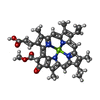 ChemComp-KC1:  ChemComp-DD6: 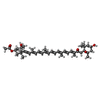 ChemComp-A86:  ChemComp-LHG:  ChemComp-LMG: 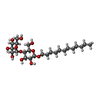 ChemComp-LMT:  ChemComp-HOH: 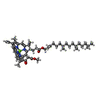 ChemComp-CL0: 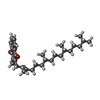 ChemComp-PQN:  ChemComp-SF4:  ChemComp-BCR: |
| Source |
|
 Keywords Keywords |  ELECTRON TRANSPORT / ELECTRON TRANSPORT /  Photosystem I Photosystem I |
 Movie
Movie Controller
Controller Structure viewers
Structure viewers About Yorodumi Papers
About Yorodumi Papers







 chaetoceros gracilis (Diatom)
chaetoceros gracilis (Diatom)